| |
:: Projimo
::
Photo Album
October 26 - November 12
Only after weeks of digesting our visit and researching PROJIMO did I
begin writing. Illustrating my experience while trying to tell their
story - their story, their dynamically colorful, painful, victorious
history - became a complicated task. As I researched I realize it is not
black and white but full of color and texture. Spreading their story is,
however, important to me. Explaining how their dreams actualized,
illustrating how struggles turned into successes, outlining how the
struggles relentlessly continue, telling their story teaches and
encourages all of us to search for our own passions and fight like hell
to achieve them . . . and hopefully we also can achieve a place of joy,
comfort, safety and love for those around us.
"No hay bien sin pero ni mal sin gracia."
(There's nothing good without a drawback
nor bad without some saving grace.)
--an old Spanish saying
HISTORY OF PROJIMO
PROJIMO is an acronym for the Program of Rehabilitation Organized by
Disabled Youth of Western Mexico. The history of PROJIMO starts with the
Ajoya clinic in a rural area of Sinaloa state. The Ajoya clinic was a
vision of David Werner. Sometime before the year 1965 David, a field
biologist, was hiking in the western Sierra Madre Mountains, where
drug-lords murder each other for control of the region's marijuana crops
and simple rural people live in dilapidated villages. David came across
a group of people carrying a man down from the mountains who was
suffering from a terrible neck injury. After a brief series of questions
David concluded that this man will inevitably be paralyzed for life due
to the lack of basic medical support where as if this man was injured in
a developed western country his fate would be entirely different. David
was and is not a doctor, but his background in biology enabled him to
see the desperate needs. His insightful heart helped to facilitate
solutions and his motivation brought health care to poor rural
communities. These endeavors led him to found
Healthwrights and write many
papers and books including Where There Are No Doctors.
The process of how primary health care came to the impoverished,
rural areas of the Sinaloa state may have started with Werner's advocacy
but it was the village people who birthed and mothered the process.
Western doctors, engineers, scientists and allied health professionals
donated their time to educate the village people, rather than just
provide services. Donations, monetary and medical supplies, were also
given, but it was the villagers who implemented the programs. The
following excerpts borrowed from the Healthwrights web page illustrate
their story better than I.
Village Health Care to the Struggle for Land and Social Justice: An
Example from Mexico
When the program started in 1965, the "diseases of poverty"
dominated the health scene. One in three children died before
reaching the age of five, primarily of diarrhea and infectious
disease combined with chronic undernutrition. Seven in ten women
were anemic, and one in ten died during or after childbirth.
Primary Heather Care and the Temptation for Excellencewriten
by David Werner
For better and for worse, the Ajoya Clinic has come a long way since
1965, when it began as a few boxes of medicines and bandages on the
front porch of the casa of blind Ramon, and its staff was no more
than an ex-schoolteacher trying hard to play medic, assisted by a
handful of over-eager village children. Then, to be sure, we had a
strong sense of community -- sometimes too strong -- for we shared
the open porch with dogs, chickens, pigs, cockroaches, a pile of
pumpkins, a corn crib, a small table at which we ate in shifts; and
five cots which at night were unfolded to sleep eight of the
household and myself.
...Over the years we have poured cement floors in the patient wards,
fixed up an X-ray darkroom (which is not quite dark), built a
workshop, put in a septic system, a flush toilet (which doesn't
always flush) and a cold shower. Last year we finished construction
of an almost modern operating room complete with scrub room,
fitfully running water, filtered air system and surgical lights
powered by our increasingly cantankerous 5 kw generator. . . Many
people have helped donate or scrounge supplies for it, so that we
now have a fair range of equipment including two fine microscopes,
scales, a macro and a micro centrifuge, and a simple but ingenious
incubator for culturing bacteria. (This last item consists of a
styrofoam box through which runs an exhaust pipe from our small
propane refrigerator. The pipe has a thermostatic shutter valve, so
that a constant temperature can be maintained in the box.) . . .Our
village apprentices, have gained more experience, our American
volunteers are better trained, our range of equipment is more
extensive and our laboratory facilities are enormously improved. In
short, one might say we practice 'better' medicine. But, is it
really better medicine?... |
Piaxtla, a villager-run health
care program, was the first project that evolved from the Ajoya clinic.
After people received the first line of medical treatment the clinic
provided general rehab care. The need for sustainable rehab care
programs became apparent, thus disabled villagers banded together to
create PROJIMO in 1982. Demonstrating immense determination and passion,
they once again rose of above poverty and the lack of resources.
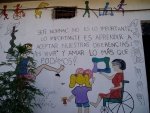 PROJIMO's primary goals is to provide high quality services at a low
cost. Services include family counseling and training, therapy, work and
skills training, brace and prosthetic fabrication, wheelchair making,
and constructing wooden toys and positioning aides. They contributed
greatly to the evolution of Community
Based Rehabilitation programs (CBR) and has inspired the books
Disabled Village Children and
Nothing
About Us Without Us. In doing so PROJIMO developed progressive
philosophies that other rehab communities adopted:
PROJIMO's primary goals is to provide high quality services at a low
cost. Services include family counseling and training, therapy, work and
skills training, brace and prosthetic fabrication, wheelchair making,
and constructing wooden toys and positioning aides. They contributed
greatly to the evolution of Community
Based Rehabilitation programs (CBR) and has inspired the books
Disabled Village Children and
Nothing
About Us Without Us. In doing so PROJIMO developed progressive
philosophies that other rehab communities adopted:
| Community Control
The community was not to be run by outsiders.
De-Professionalization The original PROJIMO team had an
average education of 3 years of primary school, however, they have
mastered many 'professional' skills. Therapists, prosthetists, and
other rehabilitation professionals are invited for short visits to
teach rather than to practice their skills. "The PROJIMO team
believes that only by simplifying rehabilitation knowledge and
skills to make them widely available in the community, can the
millions of underserved disabled children in the world receive the
basic assistance they need." [Disabled Village Children by David
Werner]
Equality between the service providers and receivers is
another philosophy of PROJIMO Visiting disabled people and their
families are invited to contribute to the project in whichever way
they can.
Self-government through group process PROJIMO has
developed different systems to try to avoid the 'boss-servant' or
hierarchical relationships. At one point in PROJIMO's history the
group elected a different program 'coordinator' (not the boss or the
leader) every month. Currently there are specific defined roles of
those who work at PROJIMO, but everyone is involved in
decision-making, planning and organizing.
Modest Earnings Wages should be they same as that of the
farming and laboring families their serve.
Unity with all who are marginalized "The PROJIMO team
views its role not only as one of helping disabled children and
their family gain power, but as part of the larger struggle for
social change and liberation of all who are 'on the bottom'." Thus
the group has participated in movements to change the social
structure and governmental policies.
Grassroots multiplying effect The PROJIMO approach has
spread in various ways: encouraged local business and schools to
install ramps and wheelchair friendly bathrooms; inspired families
of disabled children in neighboring towns to form their own special
education programs and playgrounds, invited people from other
rehabilitation communities to take back ideas back with them; helped
write manuals and books on rehab care in rural areas. |
Over the past 20 years PROJIMO
has greatly contributed to the quality of rehab care in Sinaloa's rural
areas and has served as a progressive and compassionate example for
rehab communities around the world. Not to mention the enriched lives of
those who live and work in the rehab community. Many people were
suicidal or without family before they came to PROJIMO.
Individuals, children and adults, arrived at PROJIMO to receive rehab
care and support from others with disabilities; to learn how to walk or
learn a trade or be fitted for a prosthetic limb. At any given time
there were 16- 20 people living at the project. Many times those
individuals moved to Ajoya and became active members in the community.
"PROJIMO is like a big family, mainly of young people, growing up
together. . . benefiting from rehabilitation, learning to work, and
learning to relate to each other." [Disabled Village Children by David
Werner]
The family developed ways to live as a community while providing
valuable services to people with disabilities. PROJIMO gathered great
momentum and support. PROJIMO had the only playground in town, thus the
villagers were attracted to the project and willingly volunteered. And
the wheelchair and wood shop not only produced therapeutic equipment,
but repaired bicycles and made home furniture for the pueblo. The
self-worth and self-empowerment of those who worked in the project also
soared.
In the early 1990's, the lives of those living in Ajoya were
threatened by the local drug-lords. Roberto, who still lives in Ajoya,
explained that kidnapping and deaths occurred more and more frequently.
As a child, Roberto moved to the Ajoya clinic to learn how to care for
his juvenile arthritis and soon became a passionate member. He explained
that the violent drug-lords began a turf war, shooting each other and
kidnapping people from rich families for high ransoms. Things began to
get worse in the 90's; innocent people were killed and poor families
became even poorer by being forced to gather ransom money.
| In the 1990s, however,
Ajoya began to pass through increasingly difficult times. The
economic crisis in Mexico - and the widening gap between rich and
poor that resulted from the North American Free Trade Agreement
(NAFTA) and the "global casino" of speculative investing - has led
to a tidal wave of joblessness, falling wages, crime and violence
throughout the country. As we have described in Newsletter #29, the
village of Ajoya, a strategically-located exchange point for illegal
drugs grown in the mountains, has suffered more than its share of
robberies, assaults, and kidnappings. As a response to so much crime
and violence, many families have fled the village. In the last 4
years the population has dropped from 1000 to 450.
As the result of the violence in Ajoya, in 1999 PROJIMO split
into two sub-programs. The PROJIMO Rehabilitation Program left Ajoya
and moved to the safer, more accessible town of Coyotitan on the
main west-coast highway (67 km. north of Mazatlan). For two more
years the PROJIMO Skills Training and Work Program kept its base in
the troubled village of Ajoya. Its goal was to provide socially
constructive alternatives to both disabled persons and to village
youth who, for lack of job opportunities or hopes of a viable
future, were too often lured into drugs, crime and violence. For a
time things seemed to be improving, but in the Spring of 2002, this
program also moved to a safer location. Now the new PROJIMO Work
Program is located in the small, very tranquil village of
Duranguito, about 20 km. east of Coyotitan, near the coastal town of
Dimas. [borrowed from the
Healthwrights web page ] |
The relocations of the PROJIMO and the Skills Training and Work
Program appeared to dampen the energy level, the involvement of the
community and the cohesiveness of the project. Unfortunately, the rehab
project in Coyotitan and the Work Program in Duranguito does not
frequently collaborate these days. Each program, however, continues to
do provide valuable services. The Work Program in Duranguito is
essentially a specialized wheelchair workshop. Recently they sent 30
customized wheelchairs to another state, which is a extraordinary
service.
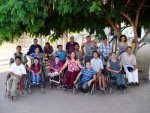 PROJIMO,
currently headed by Mary Picos and Conchita Lara, offers the same low
cost services to more costal towns and is more accessible by those in
Mazatalan or Culiacan, the capitol of Sinaloa. Individuals from
different states, large cities or tiny rural pueblos come to live at
PROJIMO to receive rehab care and contribute to the community. The 25
member team, which changes with the seasons, manages a wheelchair
workshop, a brace shop, a prosthesis shop, a toy and therapeutic
furniture shop and a therapy program. The team operates on $30,000 per
year which comes from foreign companies; they receive no money from the
Mexican government. In a year, however, they will be losing their
funding sources and are looking for Mexican and Foreign grants. David
Werner continues to visit and serves as a consultant but spends most of
his time traveling, speaking at courses and working with Healthwrights.
PROJIMO continues to improve the lives of people with disabilities and
to network with other rehab communities throughout the world. PROJIMO,
currently headed by Mary Picos and Conchita Lara, offers the same low
cost services to more costal towns and is more accessible by those in
Mazatalan or Culiacan, the capitol of Sinaloa. Individuals from
different states, large cities or tiny rural pueblos come to live at
PROJIMO to receive rehab care and contribute to the community. The 25
member team, which changes with the seasons, manages a wheelchair
workshop, a brace shop, a prosthesis shop, a toy and therapeutic
furniture shop and a therapy program. The team operates on $30,000 per
year which comes from foreign companies; they receive no money from the
Mexican government. In a year, however, they will be losing their
funding sources and are looking for Mexican and Foreign grants. David
Werner continues to visit and serves as a consultant but spends most of
his time traveling, speaking at courses and working with Healthwrights.
PROJIMO continues to improve the lives of people with disabilities and
to network with other rehab communities throughout the world.

A MINORITY IN THE FAMILY
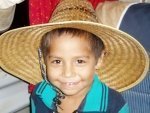 Elephante
squatted 4 meters from the Cabana, which was situated next to the
entrance of the project and in front of the coordinators' houses. Under
the shade of the cabana, a palm branch roof on stilts with two hammocks
and two benched made by splinting the trunk of a palm tree, Spanish
lessons are taught and Cocas are bought. Hence the cabana attracts much
lounging and conversing. Living so close to the hub, the pulse of the
community, we easily connection with the community- not to mention that
our home on wheels inspired many questions. A steady stream of visitors
gathered outside our front door; Jose Luis being the youngest and most
frequent, followed by Marcellito, Emily, Pedro, Nadia and Blanca. Elephante
squatted 4 meters from the Cabana, which was situated next to the
entrance of the project and in front of the coordinators' houses. Under
the shade of the cabana, a palm branch roof on stilts with two hammocks
and two benched made by splinting the trunk of a palm tree, Spanish
lessons are taught and Cocas are bought. Hence the cabana attracts much
lounging and conversing. Living so close to the hub, the pulse of the
community, we easily connection with the community- not to mention that
our home on wheels inspired many questions. A steady stream of visitors
gathered outside our front door; Jose Luis being the youngest and most
frequent, followed by Marcellito, Emily, Pedro, Nadia and Blanca.
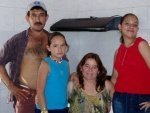 The
cabana and Elephante made a wonderful home; we were quite sufficient.
And because of that we didn't have to pay for our keep, however,
Conchita and her family opened their home to us for cooking and bathing.
We also invited people over for candle-lit meals that were cooked on our
coleman camp stove. Twice we tried to cook for them, but, well… finally
decided to leave the cooking to the locals; they are much better at it. The
cabana and Elephante made a wonderful home; we were quite sufficient.
And because of that we didn't have to pay for our keep, however,
Conchita and her family opened their home to us for cooking and bathing.
We also invited people over for candle-lit meals that were cooked on our
coleman camp stove. Twice we tried to cook for them, but, well… finally
decided to leave the cooking to the locals; they are much better at it.
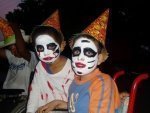 We worked but there were also terrific socialization opportunities: a
lot of hammock conversations and a couple road trips. Whether it was a
walk to the tienda for ice cream or a trip to the river, it was always a
community effort, a family outing. We had scrumptious meals at various
homes. Halloween included decorating kid's faces and shouted "¡Queremos
Halloween!" ("We want Halloween!"). On Dia de Los Muertos we visited
their ancestors at the cemetery and went to the local rodeo. We partoock
in the ceviche fest, cleaned the camerons, danced, and sang karaoke.
We worked but there were also terrific socialization opportunities: a
lot of hammock conversations and a couple road trips. Whether it was a
walk to the tienda for ice cream or a trip to the river, it was always a
community effort, a family outing. We had scrumptious meals at various
homes. Halloween included decorating kid's faces and shouted "¡Queremos
Halloween!" ("We want Halloween!"). On Dia de Los Muertos we visited
their ancestors at the cemetery and went to the local rodeo. We partoock
in the ceviche fest, cleaned the camerons, danced, and sang karaoke.
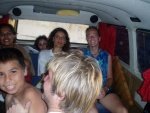 Being involved, working and living with community as a minority, was
quite an experience. Not only were we gringos, but we were able-bodied -
without a wheelchair or forearm crutches. Not that we felt any
discrimination, we actually felt like family. All 12 of us piling into
Elephante to visit the old abandoned Ajoya clinic felt like the family
was going on vacation - in the rearview mirror: aunts, cousins,
brothers, children - smiling faces, barf bags, and wheelchairs swaying
to music and bouncing with the road.
Being involved, working and living with community as a minority, was
quite an experience. Not only were we gringos, but we were able-bodied -
without a wheelchair or forearm crutches. Not that we felt any
discrimination, we actually felt like family. All 12 of us piling into
Elephante to visit the old abandoned Ajoya clinic felt like the family
was going on vacation - in the rearview mirror: aunts, cousins,
brothers, children - smiling faces, barf bags, and wheelchairs swaying
to music and bouncing with the road.

WORK AND IMPRESSIONS
Josh quickly determined the specifics of his service and a way to get
Spanish lesson. The
new PROJIMO Web
Site needed finishing and Rigo, the Spanish teacher, wanted to learn
HTML. By teaching Rigo how to create web pages PROJIMO would have an
important skill to help them communicate their cause to the world and
Josh definitely needed Spanish help.
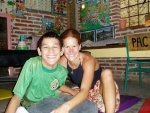 It took me, Rosita, as the locals called me, a good week to determine
how the therapy system worked ('system' being a loose term). No
documentation. Clients appeared ad-hoc. No schedule book. There was some
consistency: Dora came daily at 6:15am but didn't expect to be seen by a
therapist daily and Jorge usually came twice a day. Sometimes I was by
myself for hours. Other times the room was so crowded that people left
with a smile or gave each other therapy in the playground. Without
documentation and little communication with the other PROJIMO members,
it always came as shock when someone came in with new PROJIMO braces or
wheelchairs.
It took me, Rosita, as the locals called me, a good week to determine
how the therapy system worked ('system' being a loose term). No
documentation. Clients appeared ad-hoc. No schedule book. There was some
consistency: Dora came daily at 6:15am but didn't expect to be seen by a
therapist daily and Jorge usually came twice a day. Sometimes I was by
myself for hours. Other times the room was so crowded that people left
with a smile or gave each other therapy in the playground. Without
documentation and little communication with the other PROJIMO members,
it always came as shock when someone came in with new PROJIMO braces or
wheelchairs.
In Disabled Village Children the rural rehab manual inspired by
PROJIMO I came across the following: " We [PROJIMO]. . . are in no
position to speak with authority about 'organization and management'.
Sometimes we wonder if our achievements are due more to our
disorganization." I realized that this community has not only survived
but thrived on whimsical attention to detail while honoring the nature
of chaos; going with the flow so to not get stuck in a rut. Reading
about their history and philosophies, encouraged me to shed my western
approach and entertained the potential of chaotic successes.
While I was there, three foreign therapists were visiting and David
Werner was also visiting. Inga, from Holland, previously worked in
PROJIMO and now works for Volunteer
Services Overseas (VSO); she helped fill the gaps. The extranjero
group reviewed the intended therapy system of a CBR: Local therapist
do not need a formal education, just the heart, the mental capacity and
the motivation to learn. Formally educated therapists who are
volunteers, the extranjeros (foreigners), teach and consult. The local
therapists deliver the services, so that the clients relate to and trust
the local therapist. This helps ensure that the therapy program
continues after the volunteers leave. PROJIMO has been having a
difficult time keeping a local therapist making the therapy program
inconsistently and unmanaged.
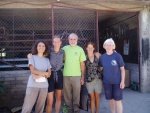 When
an extanjero leaves, they are asked to write down their suggestions and
observations. David Werner, being a long time friend of PROJIMO and an
expert on CBRs, helped facilitate a meeting. The PROJIMO team understood
the 'falta' in the therapy program - they helped write the CBR's model
of the therapy system. I felt naive, offering suggestions with such
limited experience. The coordinators, however, appeared to be interested
in objective perspectives. Operating outside the box is one of their
philosophies. When
an extanjero leaves, they are asked to write down their suggestions and
observations. David Werner, being a long time friend of PROJIMO and an
expert on CBRs, helped facilitate a meeting. The PROJIMO team understood
the 'falta' in the therapy program - they helped write the CBR's model
of the therapy system. I felt naive, offering suggestions with such
limited experience. The coordinators, however, appeared to be interested
in objective perspectives. Operating outside the box is one of their
philosophies.
During those three weeks, I positively impacted a few people's lives,
by teaching clients different therapy protocols and building therapy
equipment, scooter boards. At the local school I consulted with the
teacher and parents of a boy with Autism. And I emailed therapeutic
companies looking for donations -PROJIMO will have a computerized
exercise program. I know this sound like a cliché, but the truth
remains: I did learn much more than I was able to teach and give.
|
|
![]()